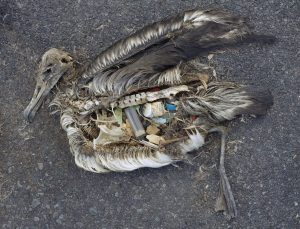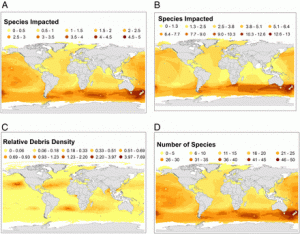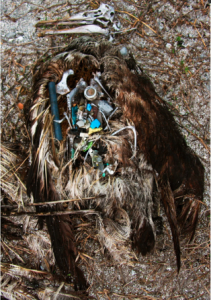Percentage of Seabird Species Ingesting Plastic Expected to Reach 99 Percent by 2050
By Laura Vander Meiden, SRC Intern
A recent study has found that if current rates of plastic introduction into the ocean continue, by 2050 approximately 99 percent of all seabird species will have ingested plastic. The study, published in September of 2015, uses a computer model based upon an analysis of data provided by past plastic-ingestion studies to come to these conclusions.

Unaltered remains of an albatross chick at Midway Atoll. Photo by Chris Jordan of the US Fish and Wildlife Service.
Plastic debris harms seabirds and other marine organisms through both entanglement and consumption. Entangled birds can lose motor abilities reducing their ability to feed and fly. Consumption of plastic can lead to pieces accumulating in the digestive system, taking up gut space typically available for food. This negatively impacts an individual’s body condition and severely reduces its ability to care for itself. In some cases, the plastic completely blocks the digestive system, leading to death. Additionally, plastics in the ocean absorb harmful chemicals that can leach out and cause damage to a seabird’s internal organs. Since approximately half of all sea bird species are in decline, these deleterious effects of plastic debris on seabirds are very concerning.
An analysis of data published in studies from 1962 to 2012 shows that 59 percent of the seabird species studied had been found to ingest plastic. Likewise, researchers found that 29 percent of the individual birds sampled in each study contained plastic in their digestive systems. Trends in this data show an average increase of 1.7 percent a year in the proportion of individuals studied that had ingested plastic. To put this in perspective, if that trend continued and those studies were to be redone today, plastic would be found in over 90% of the individual birds sampled.
Using this data, researchers created a computer model to determine areas of risk for seabird species worldwide. The model included 186 species of sea birds. Surprisingly the location of highest estimated impact was not in the Pacific Ocean, home of the infamous Great Pacific Garbage Patch, but at the boundary of the Southern Ocean between New Zealand and Australia. Though concentrations of plastic debris here are lower than other sites, this area is home to a large number of seabird species that are prone to plastic ingestion. This increases the area’s risk above those of locations with higher plastic concentrations.

It is important to remember that seabirds are not the only marine organisms affected by plastic debris. An assessment conducted by the United Nations Convention on Biological Diversity found that in 2012, 663 species were affected by marine waste, with 80 percent of the impact coming from plastic marine waste. This is up 40 percent from a previous assessment completed in 1997. Half of all marine mammal species, every species of sea turtle, and one fifth of seabird species were reported to be affected. Fifteen percent of these species are on the International Union for Conservation of Nature (IUCN) Red List, meaning they are at risk of extinction. Species of highest concern include the Hawaiian monk seal, loggerhead sea turtle, and white-chinned petrel.
The seabird study states that ingestion rates rise with increased exposure to plastic. Therefore, if the introduction of plastic into the marine ecosystem was reduced, the study’s projection that by 2050, 99 percent of seabird species will be ingesting plastic could possibly be avoided. Unfortunately, the problem will only continue to get worse unless waste management practices improve and plastic production is reduced. Commercial plastic production first began in the 1950s, over 60 years ago. If current rates of production continue, during the next 11 years we will produce the same amount of plastic as has been created since plastic production first started. Because plastic doesn’t easily biodegrade, this will effectively double the amount of plastic found on Earth.
The United Nations proposed several actions to begin to alleviate this problem. The proposed actions include reduction in the use of plastic as a packaging material, increased producer responsibility, and improved consumer awareness. These solutions are in contrast to past proposals that have only focused on waste management. However in order for a serious impact to occur, change will likely have to take place at international, national and local levels.
Works Cited
Wilcox, C., Van Sebille, E., & Hardesty, B. D. (2015). Threat of plastic pollution to seabirds is global, pervasive, and increasing. Proceedings of the National Academy of Sciences, 112(38), 11899-11904.
Secretariat of the Convention on Biological Diversity and the Scientific and Technical Advisory Panel—GEF (2012). Impacts of Marine Debris on Biodiversity: Current Status and Potential Solutions, Montreal, Technical Series No. 67.


